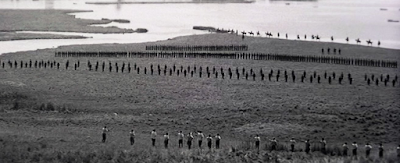Two Eastern European films that compliment each other even though they are separated by two decades:
Big Animal (2000, Poland, Jerzy Stuhr)
Fear (2020, Bulgaria, Ivaylo Hristov)
In Big Animal, a circus departs a Polish town and forgets a camel behind. As the camel wanders around town, Zygmunt (played by the director Jerzy Stuhr) decides to take the camel home.
Zygmunt and his wife Marysia (Anna Dymna) decide to adopt the camel as they have no kids of their own so they are happy to give the camel a home. There is a warmth to the couple’s behaviour and at first, the couple’s kind act is considered favourable by the locals.
However, gradually the locals prejudice comes out. They distrust the ‘foreign animal’ and consider it a burden to their town. The town blames everything bad on the camel. They shun the couple and even make Zygmunt stand a court trail.
Big Animal, based on a story by Kazimierz Orlos with screenplay co-written by Krzysztof Kieslowski, is a not so subtle allegory about how a close minded town treats a foreigner. In the end, the camel mysteriously disappears. The couple is heart-broken and they travel to visit a zoo in a bigger city, happy to witness a camel there. The couple’s smile and body language observed at the zoo indicates that their perspective has been changed forever and no matter what they do, they will stay open-hearted.
The disappeared camel makes a surprising entry near the end of Ivaylo Hristov’s Fear, which isn’t a subtle film at all. Bamba (Michael Flemming) is an African refugee who arrives on the Bulgarian border. He wants to go to Germany but ends up getting stuck in a small Bulgarian border town where he encounters Svetla (Svetlana Yancheva).
At first, Svetla is hostile towards Bamba but she reluctantly helps him and then develops an understanding with him. On the other hand, the town locals are openly racist towards Bamba and don’t hide their hatred. When the locals find out that Svetla is helping Bamba, they attack her as well.
In the end, Svetla and Bamba decide they don’t want to live in Bulgaria and plan to go to Africa. As the couple wander off into the snowy landscape, the black and white film gets a splash of colour when a camel casually walks across the screen.
The presence of the camel in Fear brilliantly ties the film with Big Animal. Of course, this isn’t the only connection. The hatred of the locals and the words they speak in Fear mirror those spoken in Big Animal with regards to the camel. Such hatred towards foreigners isn’t isolated to small European towns but sadly exists everywhere in the world. The last few years has exposed this hatred across small towns in North America.









